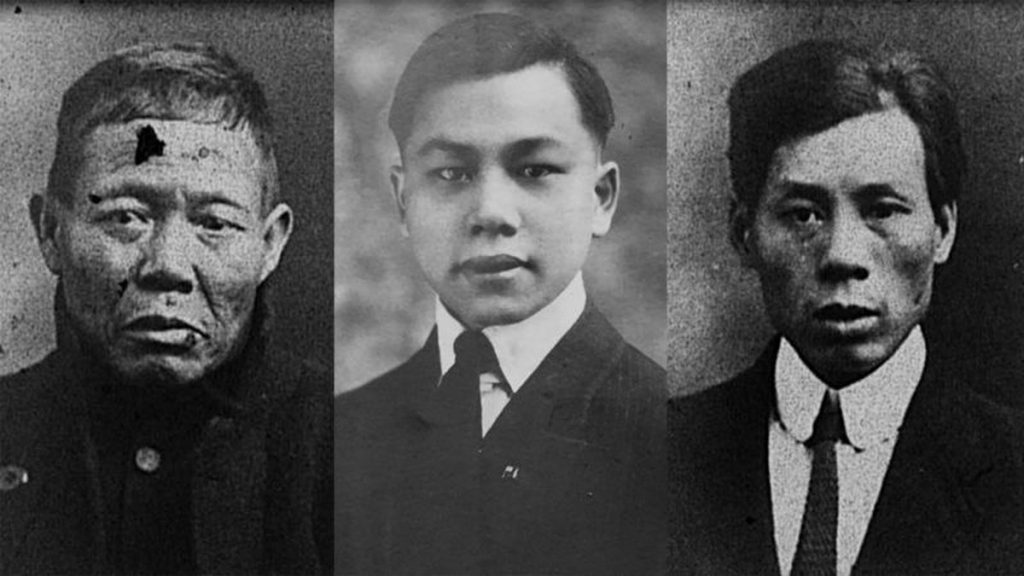When the luxury British passenger liner Titanic sank in the Atlantic Ocean in April 1912, thousands of people fell into the icy waters.
Only one lifeboat returned from the wreck to search for survivors.
In the dark, rescue team found a young Chinese man clutching a wooden door, shivering but still alive.
That man was Fang Lang, one of the six Chinese survivors of the Titanic, and his rescue was the inspiration for a famous scene in the 1997 movie Titanic in Hollywood.
But this miraculous survival wasn’t the end of his ordeal.
Twenty-four hours after they arrived at the immigrant checkpoint on Ellis Island, New York, six Chinese Titanic survivors were expelled from the country due to the Chinese Exclusion Law, a controversial and racist law prohibiting Chinese immigration to you. United State.
The Six Men disappeared from history – until now. A documentary film just opening in China, The Six, sheds light on their identities and lives on after 109 years of flight.
The ill-fated Titanic sank in 1912 – Image: Getty Images via BBC
The film reveals a story outside of Titanic, shaped by racial discrimination and anti-immigration politics that has gained special resonance today after recent hate crimes against people of Asian descent in the United States.
Who are the six Chinese survivors?
The men have been identified as Li Bing, Fang Lang, Chang Chip, Ah Lam, Chung Fu and Ling Hee. It is believed that they were sailors who were on their way to work in the Caribbean.
“As a group of people who have been together, they are strangely unknown,” Arthur Jones, the British filmmaker and director of The Six, tells the BBC.
The names of the Chinese survivors were on the ship’s passenger list, and reports of the sinking of the Titanic briefly mentioned.
But unlike other Titanic survivors who received praise in the press, Chinese men were tarnished by anti-Chinese sentiment in the West in the early 20th century, according to historians and researchers.
In a report presented days after the sinking, for example, Brooklyn Daily Eagle described the Chinese survivors as “creatures” who jumped on lifeboats “at the first sign of danger” and hid under benches.
But research by the documentary production team showed that this statement is false.
They built a replica of the Titanic lifeboat and found it impossible for the Chinese to hide without seeing them.
“I think we see the same thing today,” Jones says. “We see immigrants that are used as scapegoats by the press.”
One ticket lists the names of the eight Chinese passengers on the Titanic – six of them survived – Photo: LP Filmes
Other press coverage at the time accused Chinese men of wearing women’s clothing to prioritize riding the lifeboats.
Tim Maltin, historian of Titanic history, says there is no evidence that the Chinese survivors concealed or disguised themselves as women.
He told the BBC: “These are stories that the press and the public invented after the event.”
Rumors probably arose from the stigma attached to the many survivors of the Titanic, as the general public at the time believed that women and children should be given priority in the rescue operation.
One ticket lists the names of the eight Chinese passengers on the Titanic – six of them survived – Photo: BBC
According to Maltin, the Chinese men tried to help other survivors. Fang Lang, the man tying himself to a floating door, paddled in the lifeboat that had rescued him and helped carry everyone on board to safety.
What happened to them after the accident?
The six men were expelled from the United States, and the six men were sent to Cuba. Soon they found their way to United kingdomWhere there was a shortage of sailors, many British sailors enlisted in the army during World War I.
Zhang Chip became increasingly ill after the fateful night on the Titanic and ended up dying of pneumonia in 1914, two years after the ship sank. He was buried in an unmarked grave in a cemetery in London.
When reports of the disaster reached New York in April 1912, people gathered around newspaper billboards – Photo: Getty Images via BBC
The rest worked together in England until 1920, when the country suffered a post-war stagnation and anti-immigrant sentiment increased.
Some of these Chinese men married British women in the United Kingdom and have children. But an anti-immigration policy forced them to leave the country without warning, leaving loved ones behind.
“It wasn’t their fault,” Jones says. “All of these families are really separated from politics, which is something they had no control over.”
Ah Lam was deported to Hong Kong, while Ling Hee boarded a steamboat bound for Calcutta, India.
Li Ping immigrated to Canada, while Fang Lang, after sailing between Britain and Hong Kong for years, became a citizen of the country that once rejected him – the United States.
Similarities between history and the present day
Tom Fong, son of Fang Lang, was born in Milwaukee, Wisconsin, nearly half a century after the Titanic sank. The family name has several spellings in the English language.
For decades, he knew nothing of his father’s experience on the Titanic.
“He (Fang Lang) never spoke about it. Neither with me nor my mother,” Fong tells the BBC.
Tom Fung knows nothing of his father’s experience – Photo: BBC
Fang Lang passed away in 1985 at the age of 90. Just 20 years after his death, Fong first learns from a loved one that his father has survived the epic shipwreck.
Fong believes his father may have kept a secret about his survival on the Titanic due to a combination of trauma and stigma.
“There was a lot of information that they were sneaking under the boat and they were dressed like women …” he says. “Stories like that were circulating at that time.”
When the film’s research team tracked down the descendants of the survivors, many of them were still reluctant to share their family stories due to the stigma that their family members had suffered from a century ago.
Growing up in Wisconsin, Fong witnessed several incidents in which his father had to fight racism, including one punching a man calling them insulting names.
“(Fang Lang) was a gentleman, until he felt that he was being discriminated against because of his race,” says Fong.
More than a hundred years later, the hostility the six Chinese survivors faced has, strangely enough, resonated with racism against Asia fueled by the coronavirus pandemic.
In the US alone, thousands of cases of abuse have been reported in the past few months, ranging from spitting and verbal harassment to violent assault.
Fong chose to share his family’s story, hoping that the audience would learn about the true story of the Chinese Titanic survivors and reflect on the current events.
“If you don’t know the story, it will repeat itself,” says Fong.
Videos: International News

“Music fanatic. Professional problem solver. Reader. Award-winning tv ninja.”


:strip_icc()/s02.video.glbimg.com/x720/12532177.jpg)




More Stories
Mauro Vieira asks the Iranian advisor to exercise “maximum restraint” after the attack attributed to Israel, according to Itamaraty | world
Ukraine says it shot down the Russian military plane used in the attack Ukraine and Russia
Sabrina Petraglia's house in Dubai was flooded